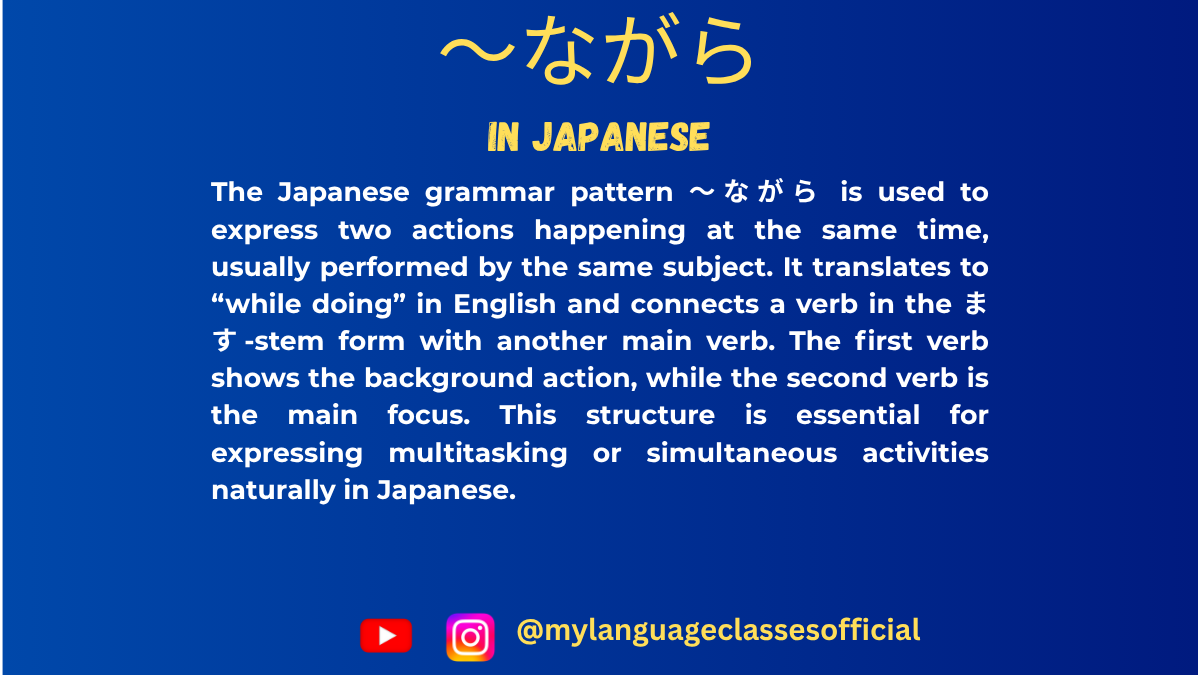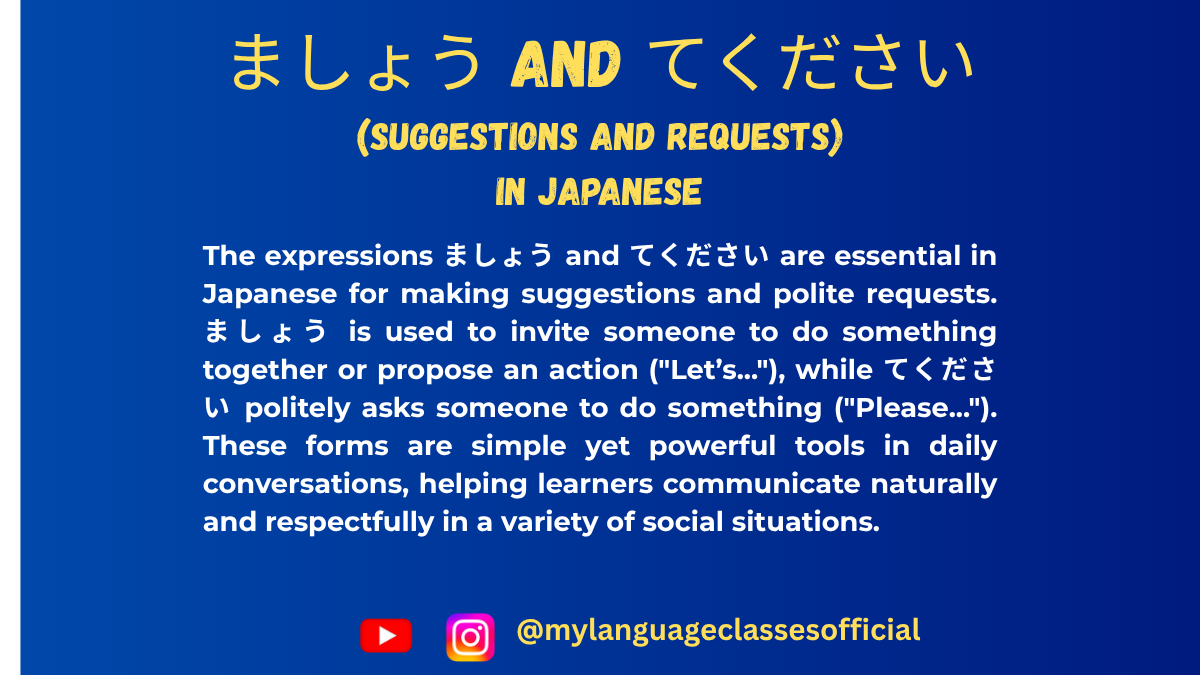Your cart is currently empty!
Tag: Japanese verb groups
-

Using 〜ながら Form in Japanese | My Language Classes
〜ながら Form in Japanese
The 〜ながら (nagara) form is an essential Japanese grammar structure used to describe two actions happening simultaneously. It is widely used in both casual and formal conversations to indicate multitasking or actions occurring at the same time.
In this blog, we will explore the formation of 〜ながら for all three verb groups, its various usages, and a comprehensive list of verbs with example sentences. Additionally, we will provide a section with more example sentences, fill-in-the-blank exercises, key points to remember, and a conclusion.
Formation of 〜ながら for Different Verb Groups
Japanese verbs are categorized into three groups: Group 1 (Godan verbs), Group 2 (Ichidan verbs), and Group 3 (Irregular verbs). Each group follows a specific rule for forming 〜ながら.
1. Group 1 (Godan Verbs)
For Godan verbs, take the ます-stem of the verb and add ながら.
- Example Formation
- 話す (hanasu – to speak) → 話しながら (hanashinagara – while speaking)
- 書く (kaku – to write) → 書きながら (kakinagara – while writing)
2. Group 2 (Ichidan Verbs)
For Ichidan verbs, remove る from the dictionary form and add ながら.
- Example Formation
- 食べる (taberu – to eat) → 食べながら (tabenagara – while eating)
- 見る (miru – to see) → 見ながら (minagara – while watching)
3. Group 3 (Irregular Verbs)
There are only two irregular verbs in Japanese: する and くる.
- Example Formation
- する (suru – to do) → しながら (shiinagara – while doing)
- くる (kuru – to come) → きながら (kinagara – while coming)
Situations Where 〜ながら Form is Used
- Describing Two Simultaneous Actions
- 音楽を聞きながら勉強する (Ongaku o kikinagara benkyou suru) – Study while listening to music.
- Multitasking in Daily Life
- テレビを見ながらご飯を食べる (Terebi o minagara gohan o taberu) – Eat while watching TV.
- Speaking While Performing Another Action
- 笑いながら話す (Warainagara hanasu) – Talk while laughing.
- Contrasting Two Simultaneous Actions
- 悲しみながら笑う (Kanashiminagara warau) – Laugh while feeling sad.
- Working or Performing a Task While Doing Something Else
- 仕事をしながらコーヒーを飲む (Shigoto o shinagara koohii o nomu) – Drink coffee while working.
Verb List with 〜ながら Form and Example Sentences
Verb (Dictionary Form) 〜ながら Form Example Sentence (Japanese) Romaji English Translation 話す (hanasu) 話しながら (hanashinagara) 彼は笑いながら話しました。 Kare wa warainagara hanashimashita. He spoke while laughing. 書く (kaku) 書きながら (kakinagara) 先生は黒板に書きながら説明した。 Sensei wa kokuban ni kakinagara setsumei shita. The teacher explained while writing on the board. 読む (yomu) 読みながら (yominagara) 彼女は本を読みながら寝てしまった。 Kanojo wa hon o yominagara nete shimatta. She fell asleep while reading a book. 見る (miru) 見ながら (minagara) 子供たちはアニメを見ながら笑った。 Kodomotachi wa anime o minagara waratta. The children laughed while watching anime. 歩く (aruku) 歩きながら (arukinagara) 彼は音楽を聞きながら歩いた。 Kare wa ongaku o kikinagara aruita. He walked while listening to music. 食べる (taberu) 食べながら (tabenagara) 彼女はテレビを見ながら食べる。 Kanojo wa terebi o minagara taberu. She eats while watching TV. 泳ぐ (oyogu) 泳ぎながら (oyoginagara) 彼は海で泳ぎながら歌った。 Kare wa umi de oyoginagara utatta. He sang while swimming in the sea.
More Example Sentences
- 音楽を聞きながら勉強する。
Ongaku o kikinagara benkyou suru.
Study while listening to music. - コーヒーを飲みながらニュースを見る。
Koohii o nominagara nyuusu o miru.
Watch the news while drinking coffee. - 料理をしながらラジオを聞く。
Ryouri o shinagara rajio o kiku.
Listen to the radio while cooking. - 車を運転しながら歌う。
Kuruma o unten shinagara utau.
Sing while driving. - 宿題をしながら電話をする。
Shukudai o shinagara denwa o suru.
Talk on the phone while doing homework.
Fill in the Blanks Questions
- 本を______ながら、リラックスします。(読む)
- 音楽を______ながら、運転する。(聞く)
- 仕事を______ながら、テレビを見る。(する)
- ご飯を______ながら、友達と話す。(食べる)
- 日本語を______ながら、メモを取る。(勉強する)
Answers
- 読みながら (yominagara)
- 聞きながら (kikinagara)
- しながら (shiinagara)
- 食べながら (tabenagara)
- 勉強しながら (benkyou shinagara)
Things to Keep in Mind
- The subject of both actions must be the same.
- The ながら clause comes before the main action.
- ながら is used only for actions, not states.
Conclusion
The 〜ながら form is an important grammar structure in Japanese that allows smooth expression of simultaneous actions. By practicing with various verbs and sentences, you will become more fluent in using it naturally in conversations.
Keep practicing and incorporating 〜ながら into your daily Japanese studies!
If you enjoyed this lesson, be sure to check out more posts like this on my blog at My Language Classes. Don’t forget to subscribe my YouTube channel and follow me on Instagram for the latest language learning tips and lessons. Leave a comment below to share your thoughts, or ask any questions you have about nouns.
Happy learning! 😊
- Example Formation
-

Making Suggestions and Polite Requests ましょう and てください in Japanese | My Language Classes
Mastering Polite Suggestions and Requests in Japanese
If you’re learning Japanese, understanding how to make polite suggestions and requests is a key part of effective communication. Whether you’re planning activities with friends or politely asking for help, two common expressions—Verb stem + ましょう and Verb stem + てください—are your go-to tools. Let’s dive into their usage, including how to form them step by step.
1. Making Suggestions with ましょう (mashou): “Let’s [verb]”
The expression ましょう is a polite and versatile way to suggest an activity or propose an idea. It carries a collaborative tone, meaning “Let’s do [verb].”
How to Form the ましょう Form
Japanese verbs are divided into three groups, and the method for creating the ましょう form depends on the group.
Group 1: U-Verbs (Godan Verbs)
- Start with the stem of the verb (remove the u-ending).
- Replace the u sound with the i sound.
- Add ましょう.
Verb Stem Change to i Form Add ましょう Example Translation 行く 行 行き 行きましょう Let’s go. 書く 書 書き 書きましょう Let’s write. 話す 話 話し 話しましょう Let’s talk.
Group 2: Ru-Verbs (Ichidan Verbs)
- Remove the final る.
- Add ましょう.
Verb Stem Add ましょう Example Translation 食べる 食べ 食べましょう Let’s eat. 見る 見 見ましょう Let’s look.
Group 3: Irregular Verbs
There are two irregular verbs, and their ましょう forms are as follows:
Verb Change to Stem Add ましょう Example Translation する し しましょう Let’s do it. 来る (kuru) 来 (ki) 来ましょう Let’s come.
When to Use ましょう
- Planning with others:
Example: 公園へ行きましょう!(Kōen e ikimashou!) = Let’s go to the park! - Encouraging teamwork:
Example: 一緒に勉強しましょう。(Issho ni benkyou shimashou.) = Let’s study together.
The tone is polite, making it suitable for formal and casual settings, as long as it’s a group-oriented activity.
2. Making Requests with てください (tekudasai): “Please [verb]”
Before diving into てください, we need to understand how to form the te-form of verbs. The te-form is one of the most fundamental conjugations in Japanese grammar and is used in various contexts beyond requests, such as making commands, linking actions, and creating the polite request structure てください.
How to Make the Te-Form
Japanese verbs are categorized into three groups, and the rules for forming the te-form differ depending on the group.
Group 1: U-Verbs (Godan Verbs)
For verbs ending in う, つ, る, む, ぶ, ぬ, く, ぐ, す, follow these rules:
- Replace the final u-sound with its corresponding te-form sound:
Ending Te-Form Rule Example う Replace with って 買う (kau) → 買って (katte) = Buy つ Replace with って 立つ (tatsu) → 立って (tatte) = Stand る Replace with って 取る (toru) → 取って (totte) = Take む Replace with んで 読む (yomu) → 読んで (yonde) = Read ぶ Replace with んで 遊ぶ (asobu) → 遊んで (asonde) = Play ぬ Replace with んで 死ぬ (shinu) → 死んで (shinde) = Die く Replace with いて 書く (kaku) → 書いて (kaite) = Write ぐ Replace with いで 泳ぐ (oyogu) → 泳いで (oyoide) = Swim す Replace with して 話す (hanasu) → 話して (hanashite) = Speak
Group 2: Ru-Verbs (Ichidan Verbs)
For verbs ending in る, simply drop る and add て:
- 食べる (taberu) → 食べて (tabete) = Eat.
- 見る (miru) → 見て (mite) = Look.
Group 3: Irregular Verbs
There are only two irregular verbs in Japanese:
- する → して = Do.
Example: 勉強する (benkyou suru) → 勉強して (benkyou shite) = Study. - 来る (kuru) → 来て (kite) = Come.
Forming てください
Once you have the te-form of a verb, simply add ください to make a polite request:
- 見る (miru) → 見て (mite) + ください = 見てください (mite kudasai) = Please look.
- 書く (kaku) → 書いて (kaite) + ください = 書いてください (kaite kudasai) = Please write.
- 手伝う (tetsudau) → 手伝って (tetsudatte) + ください = 手伝ってください (tetsudatte kudasai) = Please help.
When to Use It
- Asking politely:
Example: ちょっと待ってください。(Chotto matte kudasai.) = Please wait a moment. - Giving instructions:
Example: ドアを閉めてください。(Doa o shimete kudasai.) = Please close the door.
This phrase is polite and commonly used in both formal and informal situations.
Key Differences Between ましょう and てください
Expression Purpose Tone Verb stem + ましょう Suggestion: “Let’s do [verb]” Collaborative and inclusive Verb stem + てください Request: “Please do [verb]” Respectful and polite
Quick Practice: Try It Out!
Let’s put these into practice. Can you guess the correct form for each scenario?
- You’re suggesting to a friend: “Let’s watch a movie.”
Hint: The verb is 見る (miru).
Answer: 映画を見ましょう!(Eiga o mimashou!) - You’re asking someone politely: “Please listen to me.”
Hint: The verb is 聞く (kiku).
Answer: 私の話を聞いてください。(Watashi no hanashi o kiite kudasai.)
Conclusion
Mastering ましょう and てください opens up a world of polite and smooth communication in Japanese. By understanding these structures—and learning how to form the te-form and ましょう—you can make suggestions, request actions, and navigate various social situations with confidence. Practice them in your daily conversations, and soon they’ll become second nature!
What are your favorite phrases using ましょう or てください? Share them in the comments below! Or, if you have any questions about Japanese grammar, feel free to ask. Let’s keep learning together—日本語を楽しみましょう!(Nihongo o tanoshimimashou!) 😊
If you enjoyed this lesson, be sure to check out more posts like this on my blog at My Language Classes. Don’t forget to subscribe my YouTube channel and follow me on Instagram for the latest language learning tips and lessons. Leave a comment below to share your thoughts, or ask any questions you have about nouns.
Happy learning! 😊
